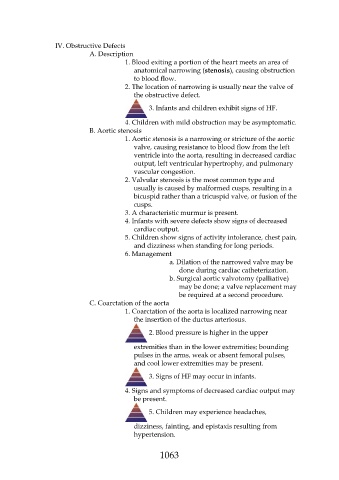Page 1063 - Saunders Comprehensive Review For NCLEX-RN
P. 1063
IV. Obstructive Defects
A. Description
1. Blood exiting a portion of the heart meets an area of
anatomical narrowing (stenosis), causing obstruction
to blood flow.
2. The location of narrowing is usually near the valve of
the obstructive defect.
3. Infants and children exhibit signs of HF.
4. Children with mild obstruction may be asymptomatic.
B. Aortic stenosis
1. Aortic stenosis is a narrowing or stricture of the aortic
valve, causing resistance to blood flow from the left
ventricle into the aorta, resulting in decreased cardiac
output, left ventricular hypertrophy, and pulmonary
vascular congestion.
2. Valvular stenosis is the most common type and
usually is caused by malformed cusps, resulting in a
bicuspid rather than a tricuspid valve, or fusion of the
cusps.
3. A characteristic murmur is present.
4. Infants with severe defects show signs of decreased
cardiac output.
5. Children show signs of activity intolerance, chest pain,
and dizziness when standing for long periods.
6. Management
a. Dilation of the narrowed valve may be
done during cardiac catheterization.
b. Surgical aortic valvotomy (palliative)
may be done; a valve replacement may
be required at a second procedure.
C. Coarctation of the aorta
1. Coarctation of the aorta is localized narrowing near
the insertion of the ductus arteriosus.
2. Blood pressure is higher in the upper
extremities than in the lower extremities; bounding
pulses in the arms, weak or absent femoral pulses,
and cool lower extremities may be present.
3. Signs of HF may occur in infants.
4. Signs and symptoms of decreased cardiac output may
be present.
5. Children may experience headaches,
dizziness, fainting, and epistaxis resulting from
hypertension.
1063

